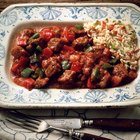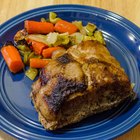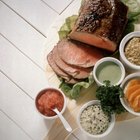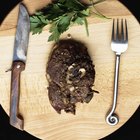
Elk shoulder doesn't give you many choices when it comes to cooking methods. Elk has poor marbling, so you don't have the fat needed to moisten the meat during slow cooking. It doesn't have much connective tissue, so you don't have the gelatin needed to tenderize it during braising. Elk does, however, give you some interesting options when it comes to flavoring. Elk eat grasses and berries, so it's only natural their meat holds flavors redolent of their diet. You can finesse the floral, woodsy notes out of elk meat by roasting it with fresh herbs and berries that taste similar to those they eat in the wild.
Step 1
Submerge the elk shoulder in a food storage container of cultured buttermilk and cover. Marinate the shoulder overnight on the bottom shelf of the refrigerator, or at least 12 hours. Lactose and enzymes in buttermilk work with amino acids and enzymes in protein to loosen strands of muscle fibers, or tenderize them, similar to how dry-aging does.
Step 2
Remove the elk shoulder and rinse the buttermilk from it. Pat the meat dry with paper towels and let it reach room temperature in a shallow dish, about one hour.
Step 3
Cover 1.5 to 2 pounds of barding fat with a few inches of cold water in a pot and bring it to a boil. Boil the barding fat for three or four minutes and rinse it in a colander with cold water. Blanching the barding fat remove most of the salt. Pat the barding fat dry with paper towels.
Step 4
Coat the elk with oil and season it to taste. You can go with kosher salt and freshly ground black pepper if you want to keep it basic. If you want to refine the flavor of the elk shoulder, use a mortar and pestle or spice grinder to mix fresh herbs and spices, such as juniper berries, cloves, fresh sage, thyme, black peppercorns and kosher salt. Mix the grind with oil to make a paste, and slather it on the meat.
Step 5
Cover the elk shoulder with a layer of barding fat. Elk has poor marbling, so you need to introduce a fat to improve its mouthfeel and help prevent it from drying out during cooking.
Step 6
Tie the shoulder with twine to hold the barding fat in place. First tie pieces of twine at 1-inch intervals crosswise around the shoulder, then tie twine at 1-inch intervals lengthwise around the shoulder, making a grid-like pattern. Heat the oven to 300 degrees Fahrenheit.
Step 7
Roughly chop a few cups of mirepoix -- 2 parts diced onion to 1 part each diced carrots and celery -- and spread it out evenly in a shallow baking dish. The mirepoix serves two purposes: it elevates the shoulder a bit so air reaches the bottom, and infuses the meat with its aromas during roasting.
Step 8
Pour a few tablespoons of water or stock in the dish. You want just enough liquid to start rendering the fat in the beginning of cooking.
Step 9
Roast the elk for about 20 minutes per pound, or until it reaches an internal temperature of 125 degrees Fahrenheit in the center, for medium-rare. Roast the elk for 25 minutes per pound, or to 130 degrees, for medium. You don't want to cook elk beyond medium. Even when barded, elk doesn't have enough fat to handle medium-well doneness, and it becomes nearly inedible.
Step 10
Remove the elk shoulder and cover it loosely with aluminum foil. Let the shoulder rest for about 30 minutes, during which time the temperature will rise 5 to 10 degrees, and the muscle will absorb and distribute a small amount of moisture -- very important when cooking elk.
Step 11
Cut the twine and remove the barding fat before serving. Cut the meat across the grain to make it easier to chew.
Related Articles
How to Cook a Lamb Square Cut Shoulder

How to Cook Veal Sirloin

How to Cook a Beef Topside Roast

How to Cook Boned Rolled Shoulder of ...

How to Make a Blackbuck Antelope Roast

How to Cook a Deer Neck Roast in a Slow ...

How to Cut Oxtail

How to Cook Deep Pit Beef in a Roaster ...
Cooking Guide for Semi-Boneless Beef ...

Slow Roasting a Leg of Lamb Until It Is ...
How to Cook a Goat Shoulder
How to Slow Cook a Pot Roast With Beef ...

How to Cook Pork Roast in an Oven
How to Cook a Whole 15-Pound New York ...

How to Cook a 15-Pound Rib Roast

How to Slow Cook an Eye of Round Roast ...

How to Cook 5 Lbs. of Beef Tenderloin
How to Cook Goat Meat in a Slow Cooker

How to Cook Lamb Shoulder Fillets on ...
How to Cook Buffalo Fillet
References
Warnings
- Don't let meat sit at room temperature longer than two hours before cooking it.
Writer Bio
A.J. Andrews' work has appeared in Food and Wine, Fricote and "BBC Good Food." He lives in Europe where he bakes with wild yeast, milks goats for cheese and prepares for the Court of Master Sommeliers level II exam. Andrews received formal training at Le Cordon Bleu.
Photo Credits
Thinkstock/Comstock/Getty Images